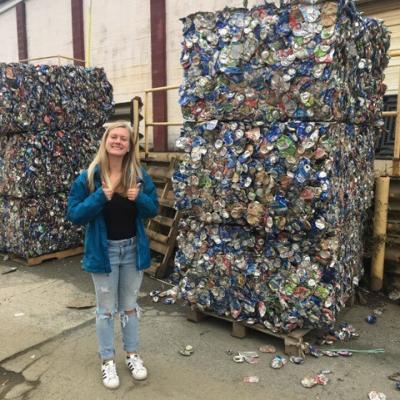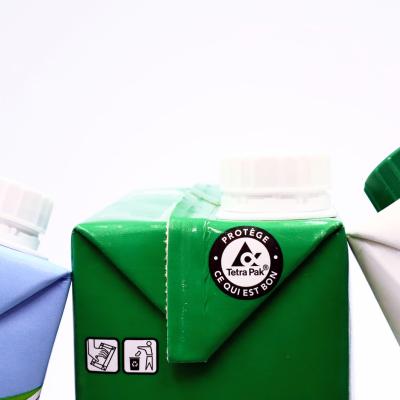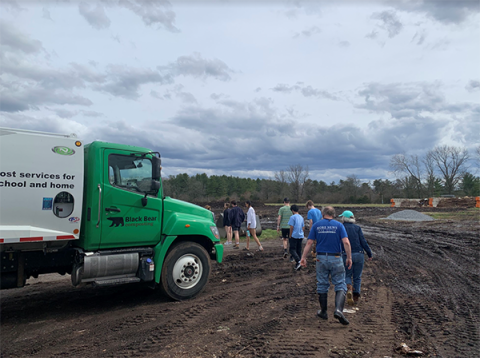UVA has an ambitious goal to reduce waste by 70% by 2030. To achieve this, it’s important to know what waste can -- and cannot – be diverted into recycling and compost streams.
By 4th-year student Julianne Feuchter
One of the biggest misconceptions that students have is that recycling and landfill bags are combined so it does not matter if you recycle your items. At UVA, these waste streams are kept separate and recycling is given to UVA recycling where it is hand-sorted to ensure each item ends up in the proper place so it can be correctly processed. While the recycling team can properly divert waste that is placed in recycling bins, they cannot do so with recyclables that end up in landfills.
Next, an incorrect belief that many people hold is that aluminum cans should be crushed before placing them in recycling bins. While it helps to crush cardboard, crushing the cans makes them blend in with the cardboard and results in the cans ending up in the wrong spot if there is single-stream recycling. Luckily, UVA divides plastic, metal, and glass from paper and cardboard so it is not a problem on Grounds. But off Grounds and later in life, make sure to keep your cans in their cylindrical shape.
Another misconception about recycling is that anything with the 3-arrow logo on it can go in the recycling bin. Unfortunately, many companies will try to appear more sustainable by advertising their materials as recyclable even if they never or rarely are recyclable. A prime example of this is tetra paks– the containers that are typically used for juice boxes and other liquids. They consist of layers of many different materials that can only be recycled in facilities that are specially equipped for them. UVA is unable to take these, so make sure that any drink containers labeled as tetra paks go to the landfill instead of the recycling center.
A misunderstanding that many upperclassmen hold is that you are unable to recycle once you move off Grounds if your building does not have a recycling bin. However, there are options for off-Grounds recycling! You can take items to local recycling centers like McIntire Recycling which is less than a mile from most off-Grounds housing.
Lastly, people often think that all cardboard food containers should go in the recycling, but if they are heavily contaminated they should be sent to the landfill. The grease from foods– like pizza– can make cardboard unrecyclable. Instead, put them in the compost if they are uncoated.
That brings me to the next section:
Composting Misconceptions
One myth about composting is that it is too difficult to do at your own house, dorm, or apartment. While composting can get messy if it is not done carefully, it is very easy to avoid common composting problems. If you are concerned that the compost will smell bad you can get a sealed container for the compost like this one, keep your compost in the freezer, or dispose of your compost more regularly. If you live on Grounds, there are compost bins at most waste stations where you take trash or recycling. If you live off Grounds, fill out this form to be part of a free composting pilot program, or set up an account with Black Bear Composting.
Another myth is that compostable products are biodegradable, so they will break down in the landfill. The composting process takes specific conditions that occur in composting facilities, not landfills, such as ideal carbon-to-nitrogen ratios, a waterproof but breathable geotextile covering, the proper temperature, and screening. When compostables end up in landfills, they emit methane – a greenhouse gas 20 times more potent than carbon dioxide – as they decompose. The composting process limits the amount of harmful greenhouse gas that enters the atmosphere, but this is a result of the composting process, not the compostable items themselves.
The last composting myth is that food waste is the only material that can go in compost bins. While food waste most definitely should go in the compost bins and is a major part of composting, there are other items you can place in compost bins as well. These include paper items such as uncoated paper plates, napkins, paper towels, and paper bags. UVA also has many compostable containers at its dining facilities. Look for cups, bowls, plates, and utensils that either say “compostable” or have the numeral “7” on them.
Get Involved
If you learned something from reading this blog, or think it would be beneficial for students to know more about composting and recycling in general, please fill out this survey that could help establish a Sustainability module for all incoming first-years. This module would help ensure that all UVA students are properly educated about recycling, composting, sustainability resources, and expectations of students.
Julianne is a 4th-year student at UVA studying Global Sustainability (B.A.); Political, Philosophy, Policy, and Law (B.A.); and French (minor). She works at UVA’s Office for Sustainability as a member of the Outreach team and is especially interested in environmental law and policy.





